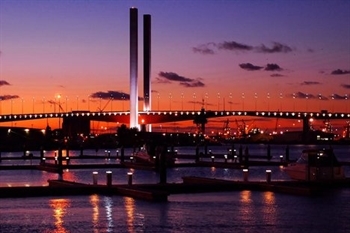
Lenscape
CityLink's aesthetic tollroad
PPP Profiles is an ongoing series of case studies on national and international public-private partnerships. To share ideas for future profiles, please contact Chrissy Nichols at cnichols@metroplanning.org.
Location: Melbourne, Australia
Project Sponsor: Melbourne City Link Authority
Private Partner: Transurban, a joint venture between Transfield and Obayashi Corporation
Project Delivery: Design, build, finance, operate, and maintain
Cost: AUS $2.2 billion
Funding Sources:
- $510 million equity
- $1.3 billion bank loans
- $51 million subordinate debt
- $350 million bonds
By 1995, residents and officials of Melbourne, Australia, had reached their limit with traffic congestion. Highways terminated on the fringes of the city, causing gridlock on residential and urban streets that were handling traffic up to 80 percent greater than capacity. With no alternative routes, freight trucks had to travel through the central business district, exacerbating congestion. Traffic had become so severe it was harming the city’s social, environmental and economic well-being.
With the help of the private sector entity Transurban, a joint venture between Transfield and Obayashi Corporation, CityLinksolved Melbourne’s traffic congestion problem. Opened in 2000, CityLink is a 13-mile electronic toll road that links three major highways around the city. Transfield designed and built CityLink over four years at a cost of $2.2 billion. The company will operate and maintain the tollroad through 2034, after which it will return CityLink to the State of Victoria.
CityLink reduced traffic congestion in Melbourne by building two links that bypass the central area and connect three highways to the north, south and west. You will not find a single toll booth on CityLink. It is one of the world's first fully electronic toll roads, allowing drivers to use the system without slowing or stopping to pay tolls. CityLink processes more than 720,000 tolls every day, all while drivers experience a steady traffic flow.

CityLink's Bolte Bridge
Lessons Learned
As intended, CityLink has achieved a range of social, economic and environmental benefits: Traffic flows better around downtown Melbourne. Vehicle access to the downtown, port, airport and rail facilities has improved. And the environment around the Yarra River has been enhanced through developing unused docklands into a residential and business district that is mainly accessable by public transit rather than cars and providing a large amount of land for open space. Average travel times have been improved by 10 to 20 minutes, resulting in $187 million in travel time savings. Additionally economic benefits include:
- 6,000 to 8,000 jobs have been created during the construction phase.
- More efficient movement of vehicles, which lowers highway maintenance costs by more than $3 million per year.
- Freight savings of $50 million per year.
- Fewer accidents, saving approximately $13 million per year.
- Industrial benefits in excess of $40 million per year including increasing the efficiency of warehouse operations, improving links between industrial zones, and creating more flexible labor markets.
- Enhanced property values of $25 to $30 million.
The environmental benefits of CityLink include more than two million trees, plants and shrubs that were planted along the toll road and its new bike and pedestrian paths.
CityLink has changed the lifestyle and landscape of Melbourne, setting a benchmark for public-private partnerships to deliver vital infrastructure projects. It is a valuable model for the Chicago region, as we plan to advance priority projects like the Elgin-O'Hare Expressway and western bypass around O’Hare Airport.

The CityLink System